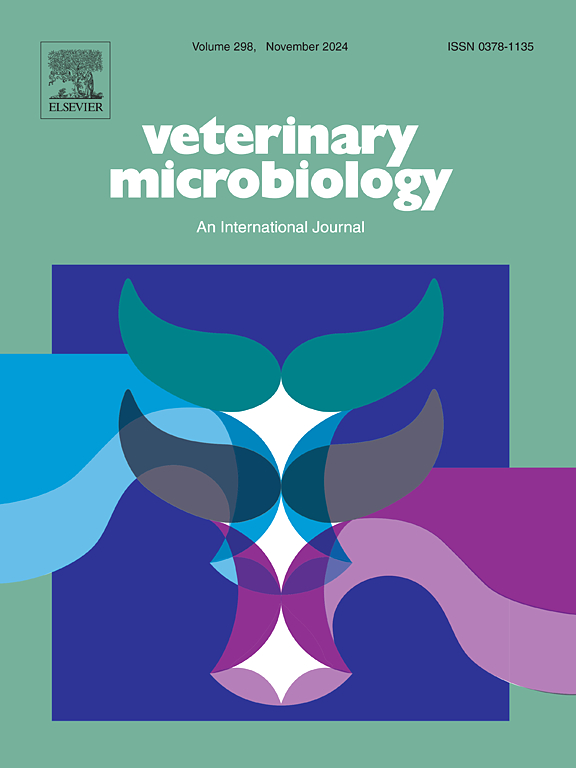伊朗蜱和犬分离的犬埃利希体TRP36基因分型研究
IF 2.4
2区 农林科学
Q3 MICROBIOLOGY
引用次数: 0
摘要
犬埃利希体是犬单核细胞埃利希体病的主要病原体,是一种由血根头蜱传播的蜱传人畜共患病,严重影响全世界犬类的健康。本研究以串联重复蛋白36 (TRP36)基因为重点,对伊朗北部地区和德黑兰市犬类分离株的流行率、遗传多样性和分子特征进行了研究。从流浪狗、收容所和家养狗身上共收集了355份血液样本和199份蜱虫样本。我们在21.4% %的血液和39.19% %的蜱类样本中检测到犬E.,在31份样本中检测到TRP36。TRP36基因的系统发育分析显示15种序列类型(STs),具有分子特征和两个高度保守区域。值得注意的是,60% %的分离株聚集在台湾基因型群内,表现出特定的氨基酸特征。我们的研究结果突出了伊朗犬伊氏绦虫的遗传多样性和流行病学特征,为了解该病原体的分子进化和区域分布提供了有价值的见解。这些结果有助于更好地了解犬埃利希体病的基因型及其对埃利希体病的诊断、治疗和流行病学控制策略的影响。本文章由计算机程序翻译,如有差异,请以英文原文为准。
Genotyping of Ehrlichia canis TRP36 isolated from ticks and dogs in Iran
Ehrlichia canis is the primary causative agent of Canine Monocytic Ehrlichiosis, a tick-borne zoonosis transmitted by Rhipicephalus sanguineus tick that significantly impacts canine health worldwide. This study investigated the prevalence rate, genetic diversity, and molecular characterization of E. canis isolated from dogs collected from northern areas of Iran and Tehran city, focusing on the tandem repeat protein 36 (TRP36) gene. A total of 355 blood samples and 199 ticks were collected from stray, sheltered, and household dogs. We identified E. canis in 21.4 % of blood and 39.19 % of tick samples, with TRP36 detected in 31 samples. Phylogenetic analysis of the TRP36 gene revealed 15 sequence types (STs), with molecular signatures and two highly conserved regions across all isolates. Notably, 60 % of isolates clustered within the Taiwan genotypic group, exhibiting specific amino acid signatures. Our findings highlight the genetic diversity and epidemiological characteristics of E. canis in Iran, providing valuable insights into the pathogen’s molecular evolution and regional distribution. These results contribute to a better understanding of E. canis genotypes and their implications for ehrlichiosis diagnostics, treatment, and epidemiological control strategies.
求助全文
通过发布文献求助,成功后即可免费获取论文全文。
去求助
来源期刊

Veterinary microbiology
农林科学-兽医学
CiteScore
5.90
自引率
6.10%
发文量
221
审稿时长
52 days
期刊介绍:
Veterinary Microbiology is concerned with microbial (bacterial, fungal, viral) diseases of domesticated vertebrate animals (livestock, companion animals, fur-bearing animals, game, poultry, fish) that supply food, other useful products or companionship. In addition, Microbial diseases of wild animals living in captivity, or as members of the feral fauna will also be considered if the infections are of interest because of their interrelation with humans (zoonoses) and/or domestic animals. Studies of antimicrobial resistance are also included, provided that the results represent a substantial advance in knowledge. Authors are strongly encouraged to read - prior to submission - the Editorials (''Scope or cope'' and ''Scope or cope II'') published previously in the journal. The Editors reserve the right to suggest submission to another journal for those papers which they feel would be more appropriate for consideration by that journal.
Original research papers of high quality and novelty on aspects of control, host response, molecular biology, pathogenesis, prevention, and treatment of microbial diseases of animals are published. Papers dealing primarily with immunology, epidemiology, molecular biology and antiviral or microbial agents will only be considered if they demonstrate a clear impact on a disease. Papers focusing solely on diagnostic techniques (such as another PCR protocol or ELISA) will not be published - focus should be on a microorganism and not on a particular technique. Papers only reporting microbial sequences, transcriptomics data, or proteomics data will not be considered unless the results represent a substantial advance in knowledge.
Drug trial papers will be considered if they have general application or significance. Papers on the identification of microorganisms will also be considered, but detailed taxonomic studies do not fall within the scope of the journal. Case reports will not be published, unless they have general application or contain novel aspects. Papers of geographically limited interest, which repeat what had been established elsewhere will not be considered. The readership of the journal is global.
 求助内容:
求助内容: 应助结果提醒方式:
应助结果提醒方式:


